Advanced Urban Law and Planning: Australia & India Housing Policies
VerifiedAdded on 2022/11/13
|6
|2137
|333
Essay
AI Summary
This essay offers a comprehensive comparison of governmental laws, policies, and strategies concerning affordable housing in Australia and India. The analysis begins by outlining the specific housing policies and legal frameworks in each country, including the Contract Act, Transfer of Property Act, and Real Estate Act in India, and governmental approaches in Australia. The essay then delves into the strengths and weaknesses of each system. The strengths of the Australian policies include providing social and economic infrastructure and securing long-term relations with private and public streams, whereas weaknesses include declining home ownership and the rising cost of housing. The strengths of the Indian policies include providing social belongingness and acceptance and enhancing economic performance, whereas weaknesses include projects often located in the city outskirts and lengthy approval processes. The essay concludes by presenting a preference for the Indian system due to its continuous efforts to develop new laws and policies to provide citizens with a better and more secured life, although the conclusion acknowledges the challenges faced by both systems.
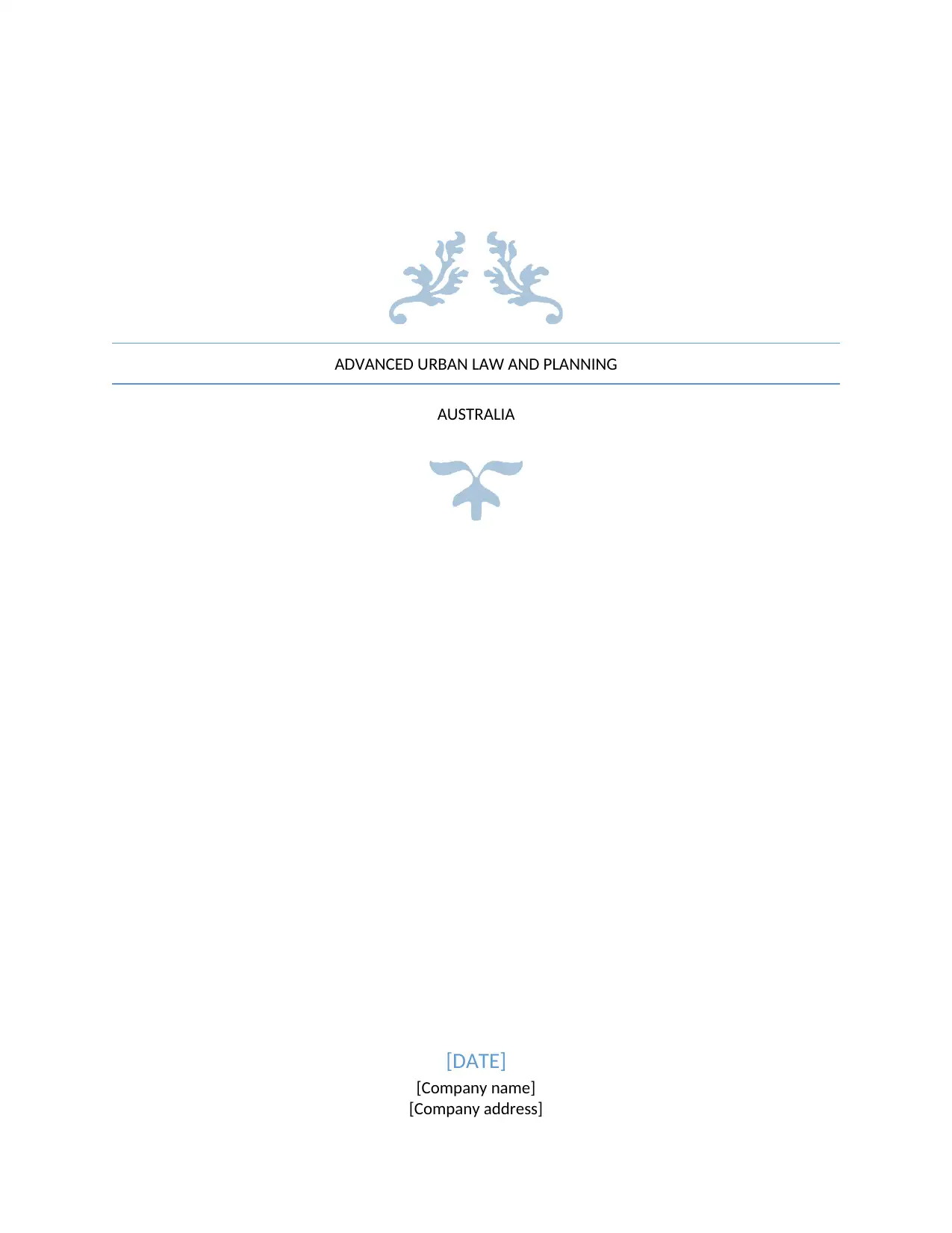
ADVANCED URBAN LAW AND PLANNING
AUSTRALIA
[DATE]
[Company name]
[Company address]
AUSTRALIA
[DATE]
[Company name]
[Company address]
Paraphrase This Document
Need a fresh take? Get an instant paraphrase of this document with our AI Paraphraser
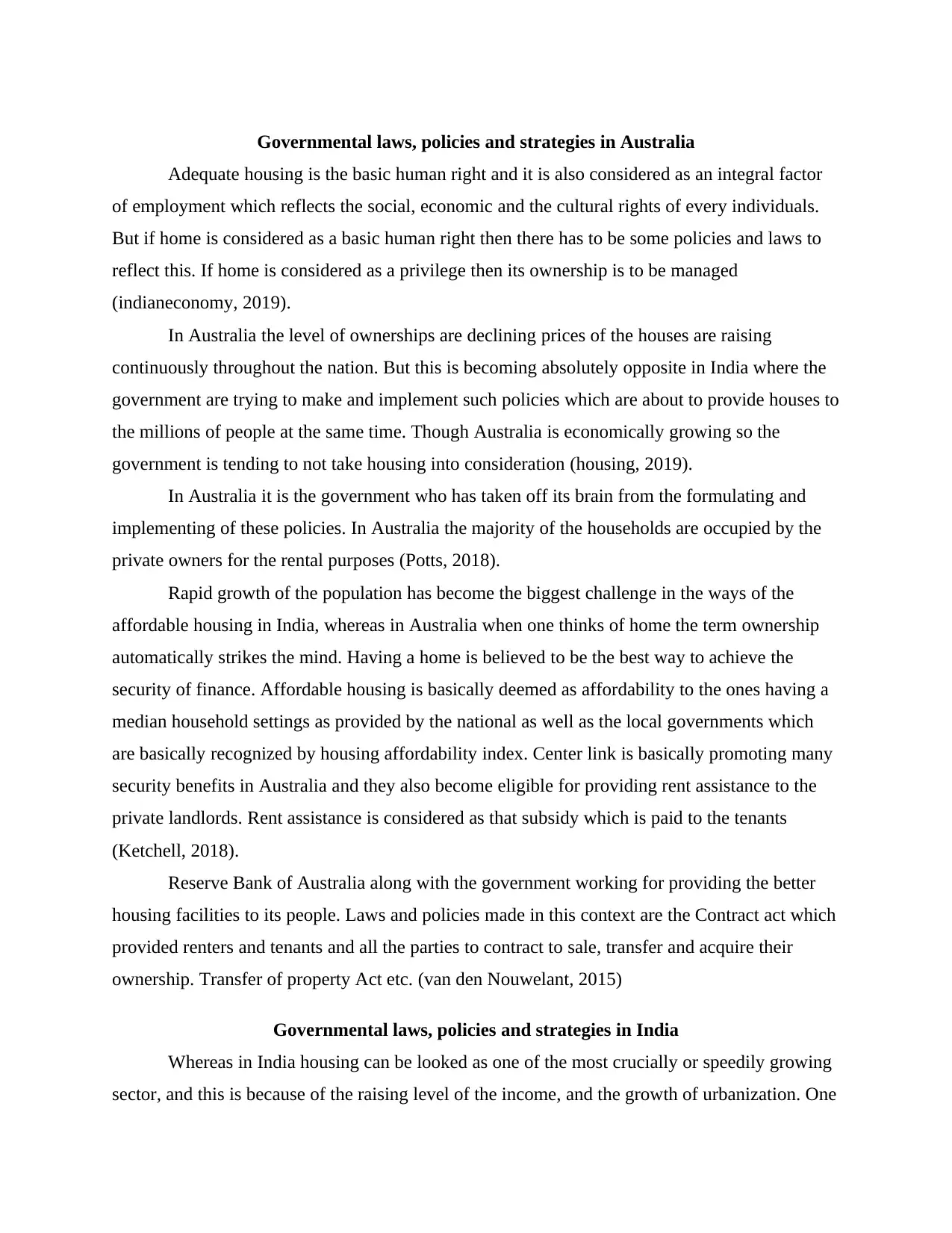
Governmental laws, policies and strategies in Australia
Adequate housing is the basic human right and it is also considered as an integral factor
of employment which reflects the social, economic and the cultural rights of every individuals.
But if home is considered as a basic human right then there has to be some policies and laws to
reflect this. If home is considered as a privilege then its ownership is to be managed
(indianeconomy, 2019).
In Australia the level of ownerships are declining prices of the houses are raising
continuously throughout the nation. But this is becoming absolutely opposite in India where the
government are trying to make and implement such policies which are about to provide houses to
the millions of people at the same time. Though Australia is economically growing so the
government is tending to not take housing into consideration (housing, 2019).
In Australia it is the government who has taken off its brain from the formulating and
implementing of these policies. In Australia the majority of the households are occupied by the
private owners for the rental purposes (Potts, 2018).
Rapid growth of the population has become the biggest challenge in the ways of the
affordable housing in India, whereas in Australia when one thinks of home the term ownership
automatically strikes the mind. Having a home is believed to be the best way to achieve the
security of finance. Affordable housing is basically deemed as affordability to the ones having a
median household settings as provided by the national as well as the local governments which
are basically recognized by housing affordability index. Center link is basically promoting many
security benefits in Australia and they also become eligible for providing rent assistance to the
private landlords. Rent assistance is considered as that subsidy which is paid to the tenants
(Ketchell, 2018).
Reserve Bank of Australia along with the government working for providing the better
housing facilities to its people. Laws and policies made in this context are the Contract act which
provided renters and tenants and all the parties to contract to sale, transfer and acquire their
ownership. Transfer of property Act etc. (van den Nouwelant, 2015)
Governmental laws, policies and strategies in India
Whereas in India housing can be looked as one of the most crucially or speedily growing
sector, and this is because of the raising level of the income, and the growth of urbanization. One
Adequate housing is the basic human right and it is also considered as an integral factor
of employment which reflects the social, economic and the cultural rights of every individuals.
But if home is considered as a basic human right then there has to be some policies and laws to
reflect this. If home is considered as a privilege then its ownership is to be managed
(indianeconomy, 2019).
In Australia the level of ownerships are declining prices of the houses are raising
continuously throughout the nation. But this is becoming absolutely opposite in India where the
government are trying to make and implement such policies which are about to provide houses to
the millions of people at the same time. Though Australia is economically growing so the
government is tending to not take housing into consideration (housing, 2019).
In Australia it is the government who has taken off its brain from the formulating and
implementing of these policies. In Australia the majority of the households are occupied by the
private owners for the rental purposes (Potts, 2018).
Rapid growth of the population has become the biggest challenge in the ways of the
affordable housing in India, whereas in Australia when one thinks of home the term ownership
automatically strikes the mind. Having a home is believed to be the best way to achieve the
security of finance. Affordable housing is basically deemed as affordability to the ones having a
median household settings as provided by the national as well as the local governments which
are basically recognized by housing affordability index. Center link is basically promoting many
security benefits in Australia and they also become eligible for providing rent assistance to the
private landlords. Rent assistance is considered as that subsidy which is paid to the tenants
(Ketchell, 2018).
Reserve Bank of Australia along with the government working for providing the better
housing facilities to its people. Laws and policies made in this context are the Contract act which
provided renters and tenants and all the parties to contract to sale, transfer and acquire their
ownership. Transfer of property Act etc. (van den Nouwelant, 2015)
Governmental laws, policies and strategies in India
Whereas in India housing can be looked as one of the most crucially or speedily growing
sector, and this is because of the raising level of the income, and the growth of urbanization. One
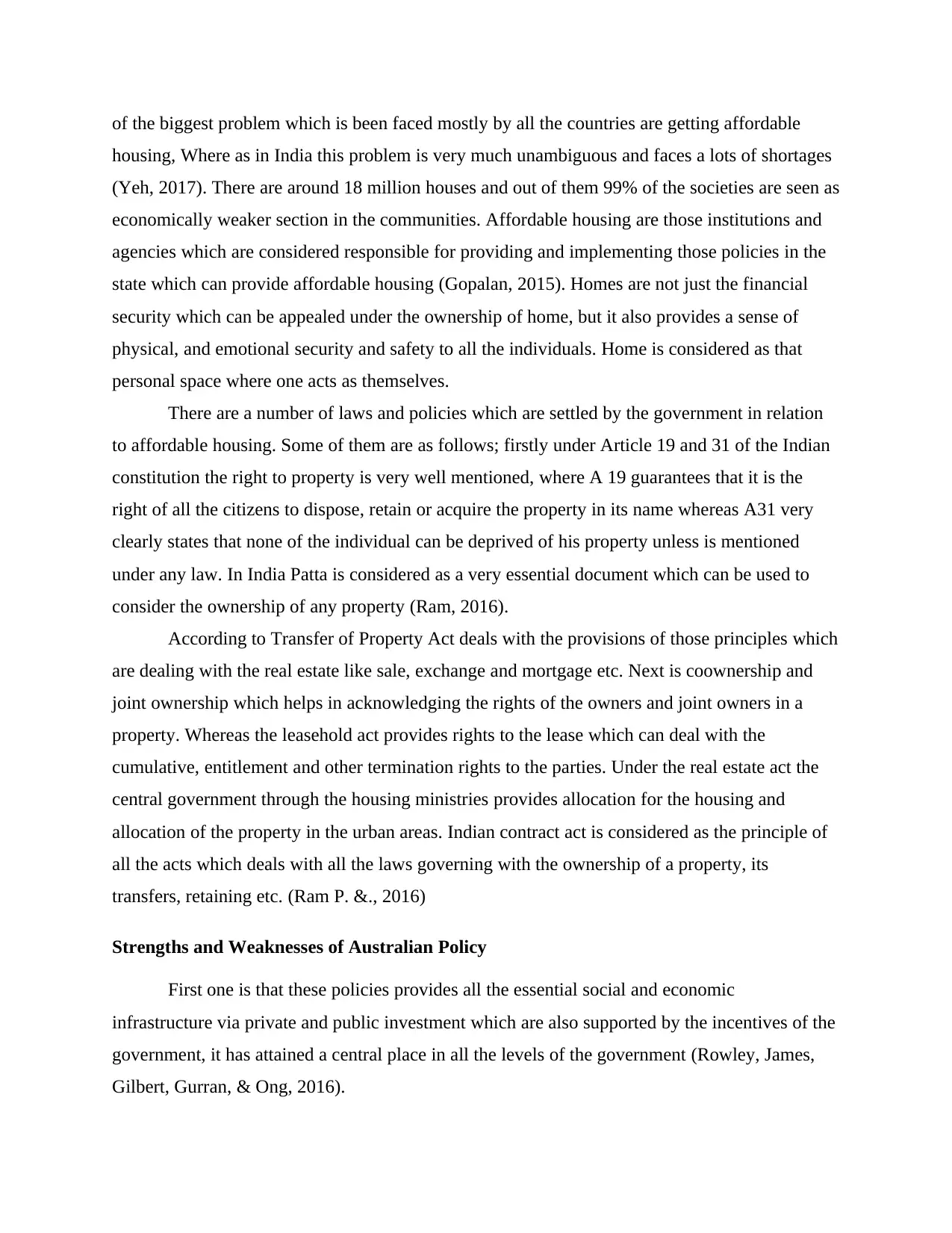
of the biggest problem which is been faced mostly by all the countries are getting affordable
housing, Where as in India this problem is very much unambiguous and faces a lots of shortages
(Yeh, 2017). There are around 18 million houses and out of them 99% of the societies are seen as
economically weaker section in the communities. Affordable housing are those institutions and
agencies which are considered responsible for providing and implementing those policies in the
state which can provide affordable housing (Gopalan, 2015). Homes are not just the financial
security which can be appealed under the ownership of home, but it also provides a sense of
physical, and emotional security and safety to all the individuals. Home is considered as that
personal space where one acts as themselves.
There are a number of laws and policies which are settled by the government in relation
to affordable housing. Some of them are as follows; firstly under Article 19 and 31 of the Indian
constitution the right to property is very well mentioned, where A 19 guarantees that it is the
right of all the citizens to dispose, retain or acquire the property in its name whereas A31 very
clearly states that none of the individual can be deprived of his property unless is mentioned
under any law. In India Patta is considered as a very essential document which can be used to
consider the ownership of any property (Ram, 2016).
According to Transfer of Property Act deals with the provisions of those principles which
are dealing with the real estate like sale, exchange and mortgage etc. Next is coownership and
joint ownership which helps in acknowledging the rights of the owners and joint owners in a
property. Whereas the leasehold act provides rights to the lease which can deal with the
cumulative, entitlement and other termination rights to the parties. Under the real estate act the
central government through the housing ministries provides allocation for the housing and
allocation of the property in the urban areas. Indian contract act is considered as the principle of
all the acts which deals with all the laws governing with the ownership of a property, its
transfers, retaining etc. (Ram P. &., 2016)
Strengths and Weaknesses of Australian Policy
First one is that these policies provides all the essential social and economic
infrastructure via private and public investment which are also supported by the incentives of the
government, it has attained a central place in all the levels of the government (Rowley, James,
Gilbert, Gurran, & Ong, 2016).
housing, Where as in India this problem is very much unambiguous and faces a lots of shortages
(Yeh, 2017). There are around 18 million houses and out of them 99% of the societies are seen as
economically weaker section in the communities. Affordable housing are those institutions and
agencies which are considered responsible for providing and implementing those policies in the
state which can provide affordable housing (Gopalan, 2015). Homes are not just the financial
security which can be appealed under the ownership of home, but it also provides a sense of
physical, and emotional security and safety to all the individuals. Home is considered as that
personal space where one acts as themselves.
There are a number of laws and policies which are settled by the government in relation
to affordable housing. Some of them are as follows; firstly under Article 19 and 31 of the Indian
constitution the right to property is very well mentioned, where A 19 guarantees that it is the
right of all the citizens to dispose, retain or acquire the property in its name whereas A31 very
clearly states that none of the individual can be deprived of his property unless is mentioned
under any law. In India Patta is considered as a very essential document which can be used to
consider the ownership of any property (Ram, 2016).
According to Transfer of Property Act deals with the provisions of those principles which
are dealing with the real estate like sale, exchange and mortgage etc. Next is coownership and
joint ownership which helps in acknowledging the rights of the owners and joint owners in a
property. Whereas the leasehold act provides rights to the lease which can deal with the
cumulative, entitlement and other termination rights to the parties. Under the real estate act the
central government through the housing ministries provides allocation for the housing and
allocation of the property in the urban areas. Indian contract act is considered as the principle of
all the acts which deals with all the laws governing with the ownership of a property, its
transfers, retaining etc. (Ram P. &., 2016)
Strengths and Weaknesses of Australian Policy
First one is that these policies provides all the essential social and economic
infrastructure via private and public investment which are also supported by the incentives of the
government, it has attained a central place in all the levels of the government (Rowley, James,
Gilbert, Gurran, & Ong, 2016).
⊘ This is a preview!⊘
Do you want full access?
Subscribe today to unlock all pages.

Trusted by 1+ million students worldwide
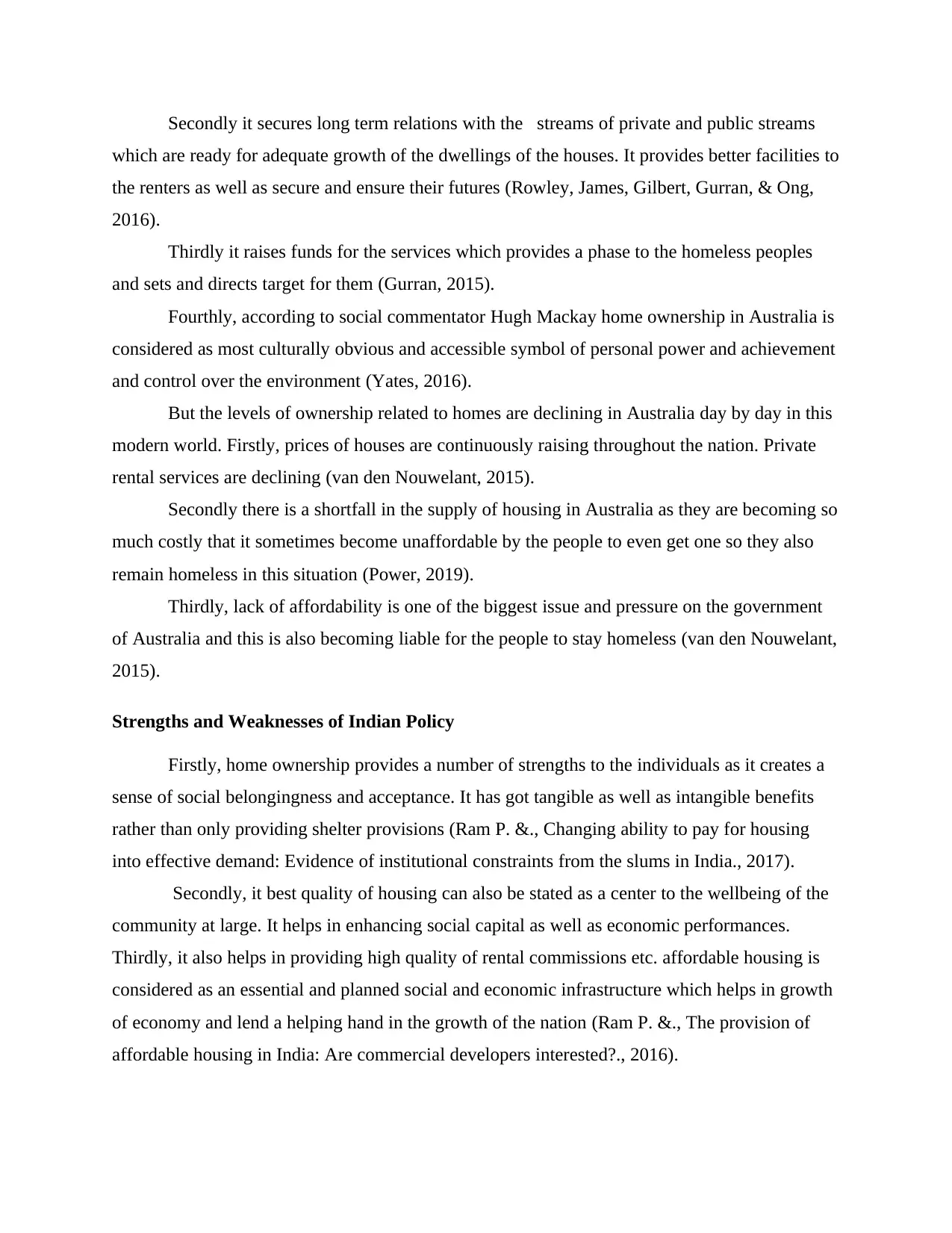
Secondly it secures long term relations with the streams of private and public streams
which are ready for adequate growth of the dwellings of the houses. It provides better facilities to
the renters as well as secure and ensure their futures (Rowley, James, Gilbert, Gurran, & Ong,
2016).
Thirdly it raises funds for the services which provides a phase to the homeless peoples
and sets and directs target for them (Gurran, 2015).
Fourthly, according to social commentator Hugh Mackay home ownership in Australia is
considered as most culturally obvious and accessible symbol of personal power and achievement
and control over the environment (Yates, 2016).
But the levels of ownership related to homes are declining in Australia day by day in this
modern world. Firstly, prices of houses are continuously raising throughout the nation. Private
rental services are declining (van den Nouwelant, 2015).
Secondly there is a shortfall in the supply of housing in Australia as they are becoming so
much costly that it sometimes become unaffordable by the people to even get one so they also
remain homeless in this situation (Power, 2019).
Thirdly, lack of affordability is one of the biggest issue and pressure on the government
of Australia and this is also becoming liable for the people to stay homeless (van den Nouwelant,
2015).
Strengths and Weaknesses of Indian Policy
Firstly, home ownership provides a number of strengths to the individuals as it creates a
sense of social belongingness and acceptance. It has got tangible as well as intangible benefits
rather than only providing shelter provisions (Ram P. &., Changing ability to pay for housing
into effective demand: Evidence of institutional constraints from the slums in India., 2017).
Secondly, it best quality of housing can also be stated as a center to the wellbeing of the
community at large. It helps in enhancing social capital as well as economic performances.
Thirdly, it also helps in providing high quality of rental commissions etc. affordable housing is
considered as an essential and planned social and economic infrastructure which helps in growth
of economy and lend a helping hand in the growth of the nation (Ram P. &., The provision of
affordable housing in India: Are commercial developers interested?., 2016).
which are ready for adequate growth of the dwellings of the houses. It provides better facilities to
the renters as well as secure and ensure their futures (Rowley, James, Gilbert, Gurran, & Ong,
2016).
Thirdly it raises funds for the services which provides a phase to the homeless peoples
and sets and directs target for them (Gurran, 2015).
Fourthly, according to social commentator Hugh Mackay home ownership in Australia is
considered as most culturally obvious and accessible symbol of personal power and achievement
and control over the environment (Yates, 2016).
But the levels of ownership related to homes are declining in Australia day by day in this
modern world. Firstly, prices of houses are continuously raising throughout the nation. Private
rental services are declining (van den Nouwelant, 2015).
Secondly there is a shortfall in the supply of housing in Australia as they are becoming so
much costly that it sometimes become unaffordable by the people to even get one so they also
remain homeless in this situation (Power, 2019).
Thirdly, lack of affordability is one of the biggest issue and pressure on the government
of Australia and this is also becoming liable for the people to stay homeless (van den Nouwelant,
2015).
Strengths and Weaknesses of Indian Policy
Firstly, home ownership provides a number of strengths to the individuals as it creates a
sense of social belongingness and acceptance. It has got tangible as well as intangible benefits
rather than only providing shelter provisions (Ram P. &., Changing ability to pay for housing
into effective demand: Evidence of institutional constraints from the slums in India., 2017).
Secondly, it best quality of housing can also be stated as a center to the wellbeing of the
community at large. It helps in enhancing social capital as well as economic performances.
Thirdly, it also helps in providing high quality of rental commissions etc. affordable housing is
considered as an essential and planned social and economic infrastructure which helps in growth
of economy and lend a helping hand in the growth of the nation (Ram P. &., The provision of
affordable housing in India: Are commercial developers interested?., 2016).
Paraphrase This Document
Need a fresh take? Get an instant paraphrase of this document with our AI Paraphraser
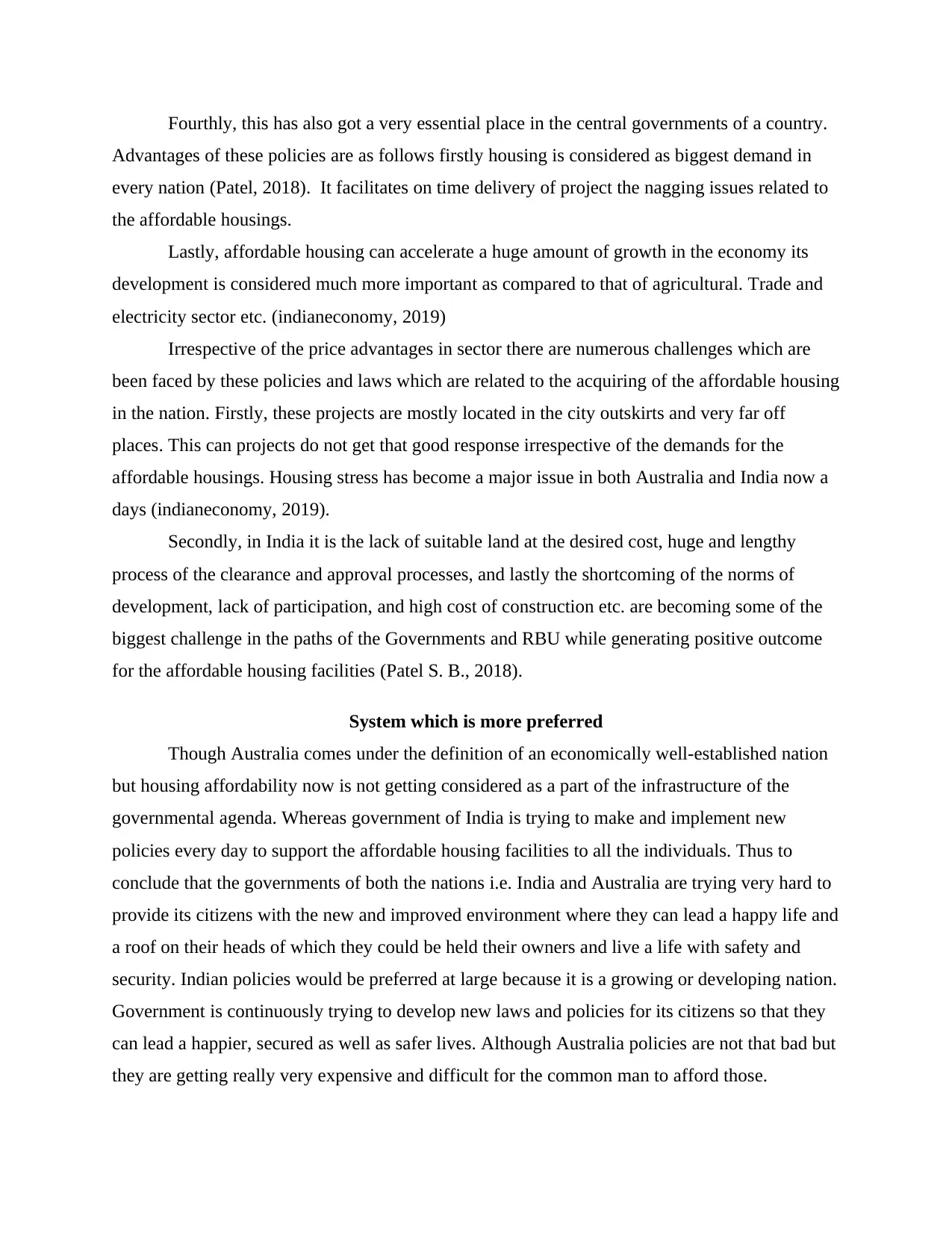
Fourthly, this has also got a very essential place in the central governments of a country.
Advantages of these policies are as follows firstly housing is considered as biggest demand in
every nation (Patel, 2018). It facilitates on time delivery of project the nagging issues related to
the affordable housings.
Lastly, affordable housing can accelerate a huge amount of growth in the economy its
development is considered much more important as compared to that of agricultural. Trade and
electricity sector etc. (indianeconomy, 2019)
Irrespective of the price advantages in sector there are numerous challenges which are
been faced by these policies and laws which are related to the acquiring of the affordable housing
in the nation. Firstly, these projects are mostly located in the city outskirts and very far off
places. This can projects do not get that good response irrespective of the demands for the
affordable housings. Housing stress has become a major issue in both Australia and India now a
days (indianeconomy, 2019).
Secondly, in India it is the lack of suitable land at the desired cost, huge and lengthy
process of the clearance and approval processes, and lastly the shortcoming of the norms of
development, lack of participation, and high cost of construction etc. are becoming some of the
biggest challenge in the paths of the Governments and RBU while generating positive outcome
for the affordable housing facilities (Patel S. B., 2018).
System which is more preferred
Though Australia comes under the definition of an economically well-established nation
but housing affordability now is not getting considered as a part of the infrastructure of the
governmental agenda. Whereas government of India is trying to make and implement new
policies every day to support the affordable housing facilities to all the individuals. Thus to
conclude that the governments of both the nations i.e. India and Australia are trying very hard to
provide its citizens with the new and improved environment where they can lead a happy life and
a roof on their heads of which they could be held their owners and live a life with safety and
security. Indian policies would be preferred at large because it is a growing or developing nation.
Government is continuously trying to develop new laws and policies for its citizens so that they
can lead a happier, secured as well as safer lives. Although Australia policies are not that bad but
they are getting really very expensive and difficult for the common man to afford those.
Advantages of these policies are as follows firstly housing is considered as biggest demand in
every nation (Patel, 2018). It facilitates on time delivery of project the nagging issues related to
the affordable housings.
Lastly, affordable housing can accelerate a huge amount of growth in the economy its
development is considered much more important as compared to that of agricultural. Trade and
electricity sector etc. (indianeconomy, 2019)
Irrespective of the price advantages in sector there are numerous challenges which are
been faced by these policies and laws which are related to the acquiring of the affordable housing
in the nation. Firstly, these projects are mostly located in the city outskirts and very far off
places. This can projects do not get that good response irrespective of the demands for the
affordable housings. Housing stress has become a major issue in both Australia and India now a
days (indianeconomy, 2019).
Secondly, in India it is the lack of suitable land at the desired cost, huge and lengthy
process of the clearance and approval processes, and lastly the shortcoming of the norms of
development, lack of participation, and high cost of construction etc. are becoming some of the
biggest challenge in the paths of the Governments and RBU while generating positive outcome
for the affordable housing facilities (Patel S. B., 2018).
System which is more preferred
Though Australia comes under the definition of an economically well-established nation
but housing affordability now is not getting considered as a part of the infrastructure of the
governmental agenda. Whereas government of India is trying to make and implement new
policies every day to support the affordable housing facilities to all the individuals. Thus to
conclude that the governments of both the nations i.e. India and Australia are trying very hard to
provide its citizens with the new and improved environment where they can lead a happy life and
a roof on their heads of which they could be held their owners and live a life with safety and
security. Indian policies would be preferred at large because it is a growing or developing nation.
Government is continuously trying to develop new laws and policies for its citizens so that they
can lead a happier, secured as well as safer lives. Although Australia policies are not that bad but
they are getting really very expensive and difficult for the common man to afford those.
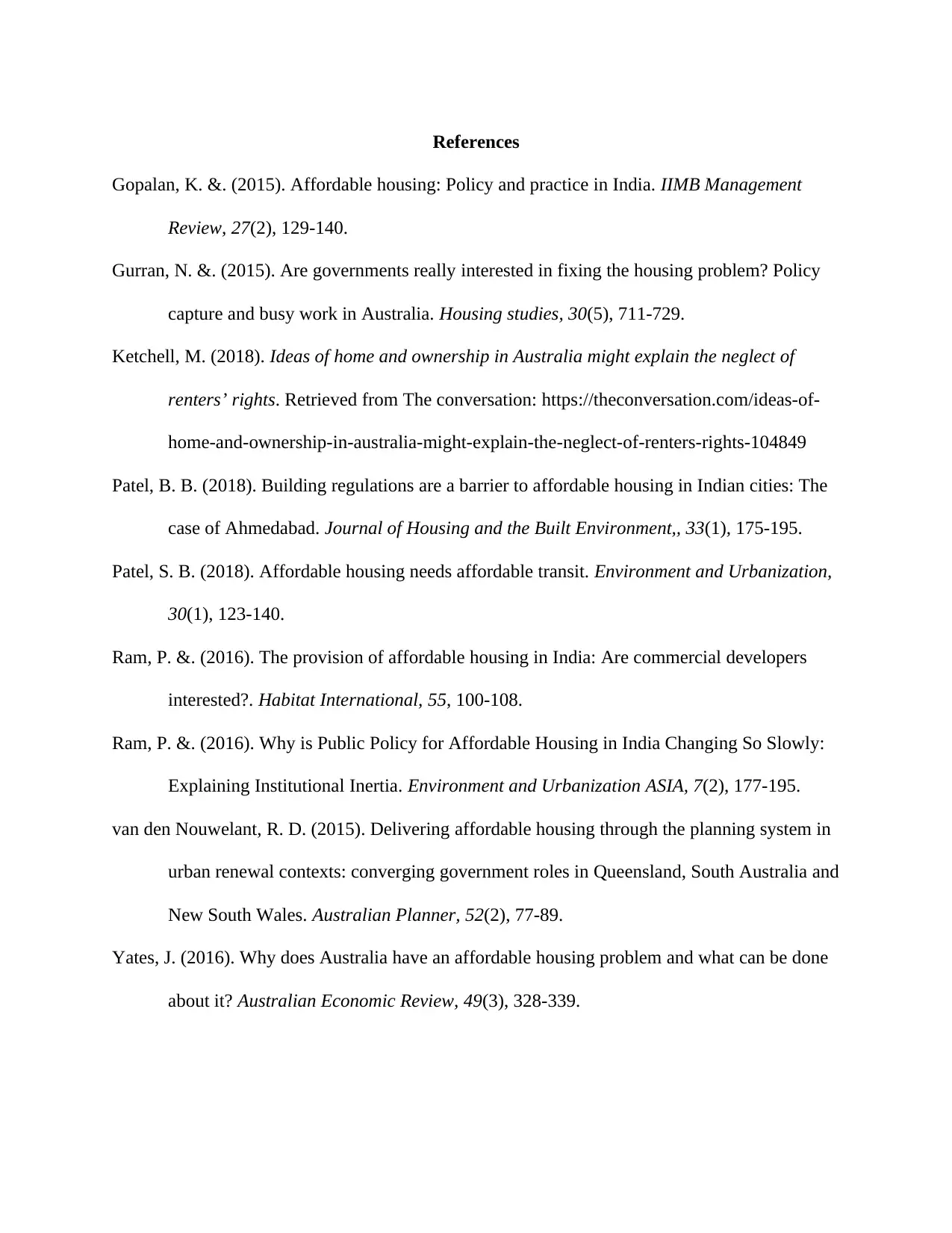
References
Gopalan, K. &. (2015). Affordable housing: Policy and practice in India. IIMB Management
Review, 27(2), 129-140.
Gurran, N. &. (2015). Are governments really interested in fixing the housing problem? Policy
capture and busy work in Australia. Housing studies, 30(5), 711-729.
Ketchell, M. (2018). Ideas of home and ownership in Australia might explain the neglect of
renters’ rights. Retrieved from The conversation: https://theconversation.com/ideas-of-
home-and-ownership-in-australia-might-explain-the-neglect-of-renters-rights-104849
Patel, B. B. (2018). Building regulations are a barrier to affordable housing in Indian cities: The
case of Ahmedabad. Journal of Housing and the Built Environment,, 33(1), 175-195.
Patel, S. B. (2018). Affordable housing needs affordable transit. Environment and Urbanization,
30(1), 123-140.
Ram, P. &. (2016). The provision of affordable housing in India: Are commercial developers
interested?. Habitat International, 55, 100-108.
Ram, P. &. (2016). Why is Public Policy for Affordable Housing in India Changing So Slowly:
Explaining Institutional Inertia. Environment and Urbanization ASIA, 7(2), 177-195.
van den Nouwelant, R. D. (2015). Delivering affordable housing through the planning system in
urban renewal contexts: converging government roles in Queensland, South Australia and
New South Wales. Australian Planner, 52(2), 77-89.
Yates, J. (2016). Why does Australia have an affordable housing problem and what can be done
about it? Australian Economic Review, 49(3), 328-339.
Gopalan, K. &. (2015). Affordable housing: Policy and practice in India. IIMB Management
Review, 27(2), 129-140.
Gurran, N. &. (2015). Are governments really interested in fixing the housing problem? Policy
capture and busy work in Australia. Housing studies, 30(5), 711-729.
Ketchell, M. (2018). Ideas of home and ownership in Australia might explain the neglect of
renters’ rights. Retrieved from The conversation: https://theconversation.com/ideas-of-
home-and-ownership-in-australia-might-explain-the-neglect-of-renters-rights-104849
Patel, B. B. (2018). Building regulations are a barrier to affordable housing in Indian cities: The
case of Ahmedabad. Journal of Housing and the Built Environment,, 33(1), 175-195.
Patel, S. B. (2018). Affordable housing needs affordable transit. Environment and Urbanization,
30(1), 123-140.
Ram, P. &. (2016). The provision of affordable housing in India: Are commercial developers
interested?. Habitat International, 55, 100-108.
Ram, P. &. (2016). Why is Public Policy for Affordable Housing in India Changing So Slowly:
Explaining Institutional Inertia. Environment and Urbanization ASIA, 7(2), 177-195.
van den Nouwelant, R. D. (2015). Delivering affordable housing through the planning system in
urban renewal contexts: converging government roles in Queensland, South Australia and
New South Wales. Australian Planner, 52(2), 77-89.
Yates, J. (2016). Why does Australia have an affordable housing problem and what can be done
about it? Australian Economic Review, 49(3), 328-339.
⊘ This is a preview!⊘
Do you want full access?
Subscribe today to unlock all pages.

Trusted by 1+ million students worldwide
1 out of 6
Related Documents
Your All-in-One AI-Powered Toolkit for Academic Success.
+13062052269
info@desklib.com
Available 24*7 on WhatsApp / Email
![[object Object]](/_next/static/media/star-bottom.7253800d.svg)
Unlock your academic potential
Copyright © 2020–2025 A2Z Services. All Rights Reserved. Developed and managed by ZUCOL.





